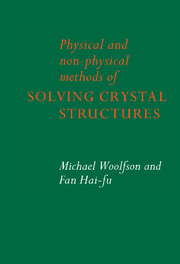Book contents
- Frontmatter
- Contents
- Preface
- 1 The basics of X-ray diffraction theory
- 2 The Patterson and heavy-atom methods
- 3 Direct methods
- 4 The basics of isomorphous replacement and anomalous scattering
- 5 Further aspects of the isomorphous replacement method
- 6 Use of anomalous scattering data
- 7 Phase extension and refinement
- 8 Multiple-beam scattering methods
- References
- Sources of non-original figures
- Index
7 - Phase extension and refinement
Published online by Cambridge University Press: 24 November 2009
- Frontmatter
- Contents
- Preface
- 1 The basics of X-ray diffraction theory
- 2 The Patterson and heavy-atom methods
- 3 Direct methods
- 4 The basics of isomorphous replacement and anomalous scattering
- 5 Further aspects of the isomorphous replacement method
- 6 Use of anomalous scattering data
- 7 Phase extension and refinement
- 8 Multiple-beam scattering methods
- References
- Sources of non-original figures
- Index
Summary
Introduction
It is easily seen from either the Sayre equation (3.52) or the tangent formula (3.60) that direct methods are likely to be much more powerful in phase extension and refinement than in ab initio phasing, since nothing can be known about the left-hand side of either the Sayre equation or the tangent formula without first putting into the right-hand side at least a small number of starting phases. One of the reasons why multi-solution procedures are so successful in practice is that they provide the possibility of having some trial sets with an initial pattern of phases able to converge to the correct point in the multi-dimensional phase space. On the other hand, if the phases of a sufficiently large number of reflections can be estimated in advance then direct methods will work even more efficiently. This gives the possibility of combining direct methods with other methods to tackle the phase problem in a number of special cases.
Fragment development
In the analysis of complex crystal structures, it is often the case that a fragment instead of the complete structure is first obtained. Hence fragment development plays an important role in crystal structure determination.
Recycling methods
Fourier synthesis with partial-structure phases has been a very efficient approach to obtaining the complete structure, especially when this is associated with weighting functions (Woolfson, 1956; Sim, 1960). A reciprocal-space alternative is a phase extension and refinement procedure based on partial structure information.
- Type
- Chapter
- Information
- Physical and Non-Physical Methods of Solving Crystal Structures , pp. 202 - 243Publisher: Cambridge University PressPrint publication year: 1995

